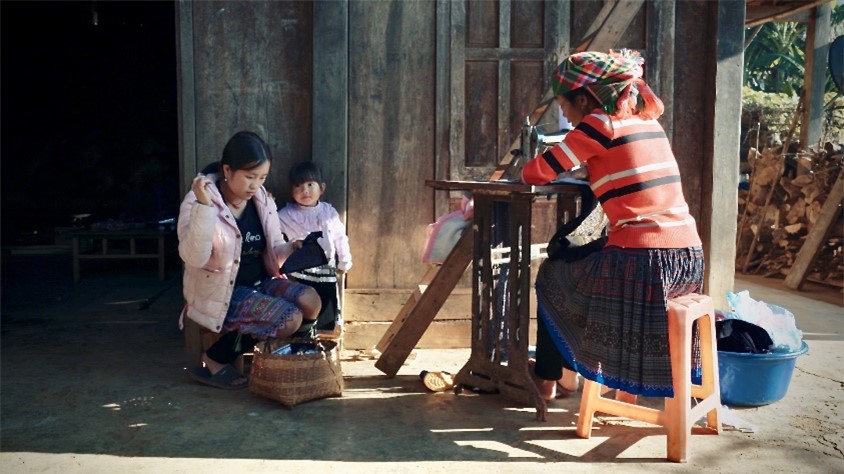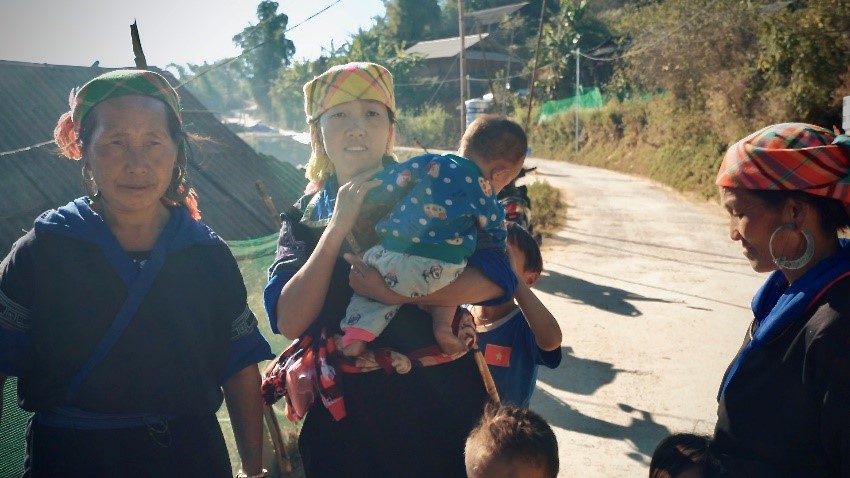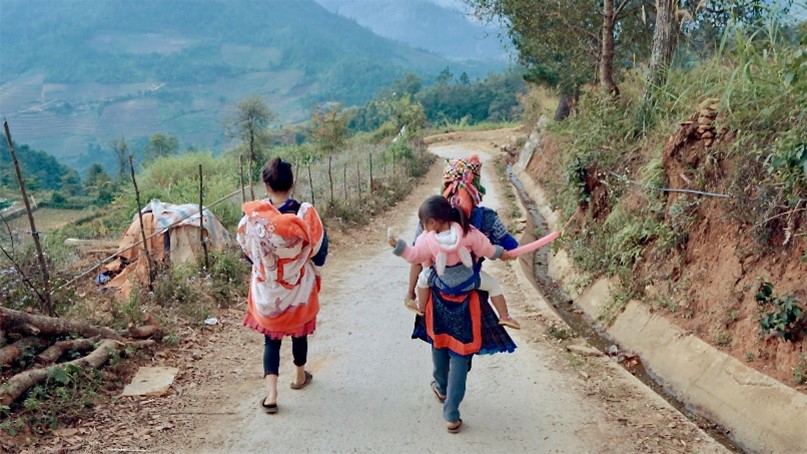Estimated reading time: 8.5 minutes
This blog is also available in Portuguese, Spanish, and Russian.
Authors: Leah Ewald and Felicity Pocklington
 Seated on the front porch of her house, perched on the side of a mountain in the vibrant green landscape of Yen Bai Province, Vietnam, with the steady sounds of daily life humming in the background, a woman named Cha tells us who she is in her own words. A young mother of two, she and her children share a household with her mother-in-law, father-in-law, two siblings, assorted ducks, three cows, and a long-suffering cat. To provide for her family, she sews clothes during the wedding season and collects wood in the off-season. Meanwhile, two kilometers away, Senior Health Station Nurse Giang tidies up the clinic in preparation for vaccination day. He worries about vaccine hesitancy in this Hmong community. He thinks it might come from local beliefs, lack of knowledge about vaccines, fear of side effects, or the difficulty of traveling to the health facility over mountainous terrain. But he and his colleagues have been investing in communication, and Cha, who is unsure which vaccines her son is getting, and cannot find her daughter’s vaccination card, has nevertheless heard enough to gather up her family and make her way on foot with her mother-in-law, her children on their backs, over the hills, to the clinic.
Seated on the front porch of her house, perched on the side of a mountain in the vibrant green landscape of Yen Bai Province, Vietnam, with the steady sounds of daily life humming in the background, a woman named Cha tells us who she is in her own words. A young mother of two, she and her children share a household with her mother-in-law, father-in-law, two siblings, assorted ducks, three cows, and a long-suffering cat. To provide for her family, she sews clothes during the wedding season and collects wood in the off-season. Meanwhile, two kilometers away, Senior Health Station Nurse Giang tidies up the clinic in preparation for vaccination day. He worries about vaccine hesitancy in this Hmong community. He thinks it might come from local beliefs, lack of knowledge about vaccines, fear of side effects, or the difficulty of traveling to the health facility over mountainous terrain. But he and his colleagues have been investing in communication, and Cha, who is unsure which vaccines her son is getting, and cannot find her daughter’s vaccination card, has nevertheless heard enough to gather up her family and make her way on foot with her mother-in-law, her children on their backs, over the hills, to the clinic.
“Humans think in stories, and we try to make sense of the world by telling stories.” – Yuval Noah Harari
Concerns like Giang’s about vaccine hesitancy or low demand, especially in “hard-to-reach” or marginalized communities, grow increasingly common as countries attempt to reach every child with life-saving vaccines. Countries began receiving their first deliveries of vaccines from COVAX at the end of last month, a spark of hope to mark a turning point in the pandemic. On the other hand, a pulse survey conducted in July 2020 indicated that of 260 immunization professionals in 82 countries, 73% reported a disruption in immunization demand during the pandemic. By that time, 15 of 40 Gavi-eligible countries had indicated an increased spread of rumors and misinformation, with 21 noting a moderate or high impact on public trust for immunization. These findings indicate that the COVID-19 pandemic has likely accelerated global trends of increasing vaccine hesitancy. As we stand on the precipice of a new historical moment for immunization with the upcoming rollout of the COVID vaccine, the specter of rumors, misinformation, mistrust, and hesitancy pose a growing and complex challenge, particularly in an increasingly digital world.
LNCT, in partnership with Common Thread, is pleased to announce the launch of two new case studies on vaccine demand in Vietnam that offer an exemplary model of how to engage with vulnerable communities. The stories detail the immunization journeys of young mothers Cha and Do through short films to be used for health worker capacity building. In these films, we chose to allow Cha and Do to tell their own stories, free from external narration or flashy graphics, so that we could listen carefully to their immunization journeys, understand the challenges they face, and learn how we could make their experiences a little easier. The result is two remarkably powerful tales of families overcoming every obstacle to protect their children from vaccine preventable disease.
In light of this announcement, we wanted to take a moment to reflect on the value of stories – both listening to and telling them – in an era of vaccine hesitancy. Below are some of our thoughts.
Data doesn’t change people’s minds, but emotions do.
Stories are one of the most effective communication techniques to change behavior. A good story converts dry data to information that is personal and relatable. It can build understanding of a complex issue. It stirs emotions like laughter, anger, sadness, fear, or pride, which are critical for the long-term retention of information. It unites the listener with the teller in a shared sense of purpose. It creates empathy and motivates action. It builds emotion. Consider the difference between these messages:
- “115 children died of diphtheria after an outbreak in Vietnam last year. Vaccinate your child today.”
- “Ha was three-years-old — a proud big sister who liked to help her mother sew. She loved her dog, her grandmother, and anything sweet. She died of diphtheria last year, in a small farming community just like this one. Vaccinate your child today.”
The first tells us of a risk through a number without context. The second evokes recognition, sadness, and fear. As Giang notes, effective communication is critical for overcoming the challenge of hesitancy – for helping people understand and remember the importance, effectiveness, and safety of vaccines and for motivating them to act even in the face of major barriers, like arduous journeys on foot and the loss of a day’s labor. Effective communication of stories like Cha’s is also critical for helping health workers and policymakers understand the needs of the communities they serve.
Stories help us understand the people hidden behind numbers.
 With 13 years of experience, Giang’s perspective about what might be influencing his community’s immunization behaviors is limited by what he can see at the health clinic, and by what people tell him as a health worker. By listening to Cha and her family tell their story, we gain a much richer understanding of what UNICEF calls the “Journey to Immunization” – all of the various steps that a caregiver must overcome to vaccinate their child, from gaining knowledge and awareness, to establishing intent to vaccinate, to preparing to act, to accepting the cost and effort, to experiencing an immunization session at the facility, to experiencing any side effects after vaccination, to deciding to return for more doses. Numbers may tell us the “who, what, where, and when” of vaccine hesitancy or low demand for immunization, and experiential knowledge like Giang’s may allow us to guess at the “why,” but it is difficult to fully understand the decisions of families like Cha’s without “taking a walk in their shoes.”
With 13 years of experience, Giang’s perspective about what might be influencing his community’s immunization behaviors is limited by what he can see at the health clinic, and by what people tell him as a health worker. By listening to Cha and her family tell their story, we gain a much richer understanding of what UNICEF calls the “Journey to Immunization” – all of the various steps that a caregiver must overcome to vaccinate their child, from gaining knowledge and awareness, to establishing intent to vaccinate, to preparing to act, to accepting the cost and effort, to experiencing an immunization session at the facility, to experiencing any side effects after vaccination, to deciding to return for more doses. Numbers may tell us the “who, what, where, and when” of vaccine hesitancy or low demand for immunization, and experiential knowledge like Giang’s may allow us to guess at the “why,” but it is difficult to fully understand the decisions of families like Cha’s without “taking a walk in their shoes.”
Listening to Cha’s story, we can gather a wealth of information about what might cause someone in a community like hers to miss an immunization session – and it does not all come down to a lack of demand for immunization. We can also start to understand all the things that dedicated health workers might do to overcome these barriers: they can hold immunization outreach sessions closer to the communities; they can offer masks and hand sanitizer to caregivers when they arrive; they can take time to explain the potential side effects of vaccination in a language the caregivers understand; they can send invitations to remind caregivers of upcoming vaccination sessions. We can then turn to quantitative data to test these theories – how common are each of these barriers? Which are the most important? Are the health worker’s strategies working to address these issues? Is there something we are still missing?
Stories come in all shapes and sizes.
 You do not need to be a prolific writer to tell a good story, nor do you need to find tens of hours to set aside to craft your narrative. A story could be told in a three-page blog, like this one. Or it could be a few sentences, like this one from Cha’s father-in-law: “In the past, there were no vaccines or medicine. Instead, we went to the forest to get medicine. It was difficult finding medicine in the forest. Some were cured, some weren’t.” Sometimes a picture is enough to tell a story, like this one of Cha and her mother-in-law traveling to the vaccination site on foot across hilly terrain. A story, in its broadest sense, is a narrative that allows its audience to experience something with its teller, be it a problem, an emotion, a journey, or a message. It could be used to explain to a health worker why a person is not taking their child for vaccination, to motivate a caregiver to vaccinate, to advocate for funding for a needed tool, to teach a health worker how to complete a task, or to encourage and re-energize a health worker on the verge of a burnout. The key is to find a medium that works for your skills, message, and resources. For guidance on how to tell an effective story, check out this storytelling template.
You do not need to be a prolific writer to tell a good story, nor do you need to find tens of hours to set aside to craft your narrative. A story could be told in a three-page blog, like this one. Or it could be a few sentences, like this one from Cha’s father-in-law: “In the past, there were no vaccines or medicine. Instead, we went to the forest to get medicine. It was difficult finding medicine in the forest. Some were cured, some weren’t.” Sometimes a picture is enough to tell a story, like this one of Cha and her mother-in-law traveling to the vaccination site on foot across hilly terrain. A story, in its broadest sense, is a narrative that allows its audience to experience something with its teller, be it a problem, an emotion, a journey, or a message. It could be used to explain to a health worker why a person is not taking their child for vaccination, to motivate a caregiver to vaccinate, to advocate for funding for a needed tool, to teach a health worker how to complete a task, or to encourage and re-energize a health worker on the verge of a burnout. The key is to find a medium that works for your skills, message, and resources. For guidance on how to tell an effective story, check out this storytelling template.
Everyone has their own story, and they are all worth listening to.
 People tend to trust health professionals and government officials, which gives them a great deal of storytelling power. But we also must take care to approach the way that we tell stories about vaccine hesitant communities who may be marginalized or vulnerable with care and respect, recognizing that in the end we are all primarily concerned with the well-being of our children. We can tell stories of mothers who give up a day of necessary work to travel to a health clinic on foot. We can tell the stories of fathers who take the time to call home from the factory and wish their families well on vaccination day. We can tell the stories of mothers-in-law and fathers-in-law who support their grandchildren’s immunization journey through labor and moral support. We can tell the stories of resourceful health workers who come from the communities they tirelessly serve. By using our storytelling power to give voice to those who often go unheard, we have the power to depict the caregivers who make the often difficult and halting journey to immunization as they are: persistent, devoted to their children, persevering, and in some sense, heroic. These kinds of stories build trust and a shared sense of purpose between health workers and communities, and in helping to change the way we view “hard-to-reach” communities, can make a difference that stretches beyond immunization.
People tend to trust health professionals and government officials, which gives them a great deal of storytelling power. But we also must take care to approach the way that we tell stories about vaccine hesitant communities who may be marginalized or vulnerable with care and respect, recognizing that in the end we are all primarily concerned with the well-being of our children. We can tell stories of mothers who give up a day of necessary work to travel to a health clinic on foot. We can tell the stories of fathers who take the time to call home from the factory and wish their families well on vaccination day. We can tell the stories of mothers-in-law and fathers-in-law who support their grandchildren’s immunization journey through labor and moral support. We can tell the stories of resourceful health workers who come from the communities they tirelessly serve. By using our storytelling power to give voice to those who often go unheard, we have the power to depict the caregivers who make the often difficult and halting journey to immunization as they are: persistent, devoted to their children, persevering, and in some sense, heroic. These kinds of stories build trust and a shared sense of purpose between health workers and communities, and in helping to change the way we view “hard-to-reach” communities, can make a difference that stretches beyond immunization.
You can watch Cha’s story, and that of another young mother, Do, in English, French, Portuguese, and Russian here. LNCT is making these videos available for anyone to adapt to their own country’s health worker trainings on communications, demand generation, and assessing the barriers to immunization. A trainers’ discussion guide is also available in English, French, Portuguese, and Russian.
Do you have a heroic story of immunization during the pandemic to share? We invite you to post it in the comments, below! Also, make sure you stay updated on the latest network offerings and learnings by signing up for our email list!
